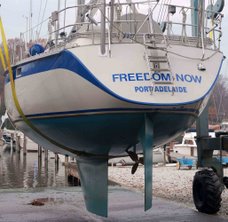 The sailing and navigating to Lunenburg was easy, gentle breezes and smooth seas. Before we arrived in the entrance of the harbour a mist had rolled in and we were greeted by a fleet of schooners. It was the day of the annual schooner race. They presented a wonderful sight. We were able to sail right into the harbour and just as we entered we were greeted by the most famous of all the schooners Bluenose 11 as she left with a load of paying customers. She is a replica of the original Bluenose Schooner whose image graces the Canadian dime. Launched in 1921 as a fishing schooner she was designed to be not only a grand banks fishing boat but also the fastest working schooner the world had ever seen. The America's Cup was regarded as something for sissies and only sailed in light winds. This was a boat for all seasons and out sailed every other working schooner ever built. She was unbeaten in her home waters. She was eventually sold and wrecked on the shoals of Haiti. During her quarter of a century as the Queen of the ocean she had caught the imagination of people around the world. The replica that greeted us was built in Lunenburg at the same shipyard as the original and although it is debated by some of the locals she is as close as possible an exact copy of the original and a truly magnificent sight. We were in Lunenburg for 6 days and every day we went ashore in our dinghy we tied up at a dinghy dock alongside Bluenose 11 and never ceased to lose our awe at the sheer beauty of her lines.
The sailing and navigating to Lunenburg was easy, gentle breezes and smooth seas. Before we arrived in the entrance of the harbour a mist had rolled in and we were greeted by a fleet of schooners. It was the day of the annual schooner race. They presented a wonderful sight. We were able to sail right into the harbour and just as we entered we were greeted by the most famous of all the schooners Bluenose 11 as she left with a load of paying customers. She is a replica of the original Bluenose Schooner whose image graces the Canadian dime. Launched in 1921 as a fishing schooner she was designed to be not only a grand banks fishing boat but also the fastest working schooner the world had ever seen. The America's Cup was regarded as something for sissies and only sailed in light winds. This was a boat for all seasons and out sailed every other working schooner ever built. She was unbeaten in her home waters. She was eventually sold and wrecked on the shoals of Haiti. During her quarter of a century as the Queen of the ocean she had caught the imagination of people around the world. The replica that greeted us was built in Lunenburg at the same shipyard as the original and although it is debated by some of the locals she is as close as possible an exact copy of the original and a truly magnificent sight. We were in Lunenburg for 6 days and every day we went ashore in our dinghy we tied up at a dinghy dock alongside Bluenose 11 and never ceased to lose our awe at the sheer beauty of her lines. 
There is more to Lunenburg than the Bluenose 11. When Cornwallis established Halifax as a British harbour in 1749 he decided that the settlers already living there who were not British should be moved so 453 people (about two-thirds German, one third French and Swiss) were transported to Lunenberg so named to honour George II of England who as Elector of Hanover held the Duchy of Lunenburg in Germany.
Many of the buildings hold a charm and character of old Europe, the protestant churches including a large Lutheran church dominate the skyline and the surnames of the residents still contain many straight from a German or French phone directory. Our shaken down motor was checked by a mechanic named Knickle a direct descendant from an original German family.
We enjoyed a lamb barbecue to celebrate the end of the schooner race, visited numerous galleries, cafes and churches including the magnificent Anglican church rebuilt after a fire in the original carpentry Gothic style. There we shared in an hour of pipe organ recital and hymns.
We spent considerable time with Keith and Ann who now had their boat Ketchup II in the boat yard with two big holes in the hull and all the hassles of trying to get the right epoxy bond and plaster work done to repair her ferro cement hull. They had run foul of some uncharted rocks further up the coast. They have created a stir among the Canadian Hydrography Department.
We needed to press on and thought we would sail to Port Mouton so named because Champlain lost a sheep overboard there in 1604. The winds were too good for that so at the last minute we decided to sail straight through to Shelburne. We were hitting 8 knots or more in NW breeze of 20-25 knots and picked up a mooring at the Shelburne Yacht Club just before dark having travelled 85 nautical miles in less than 12 hours.

No comments:
Post a Comment